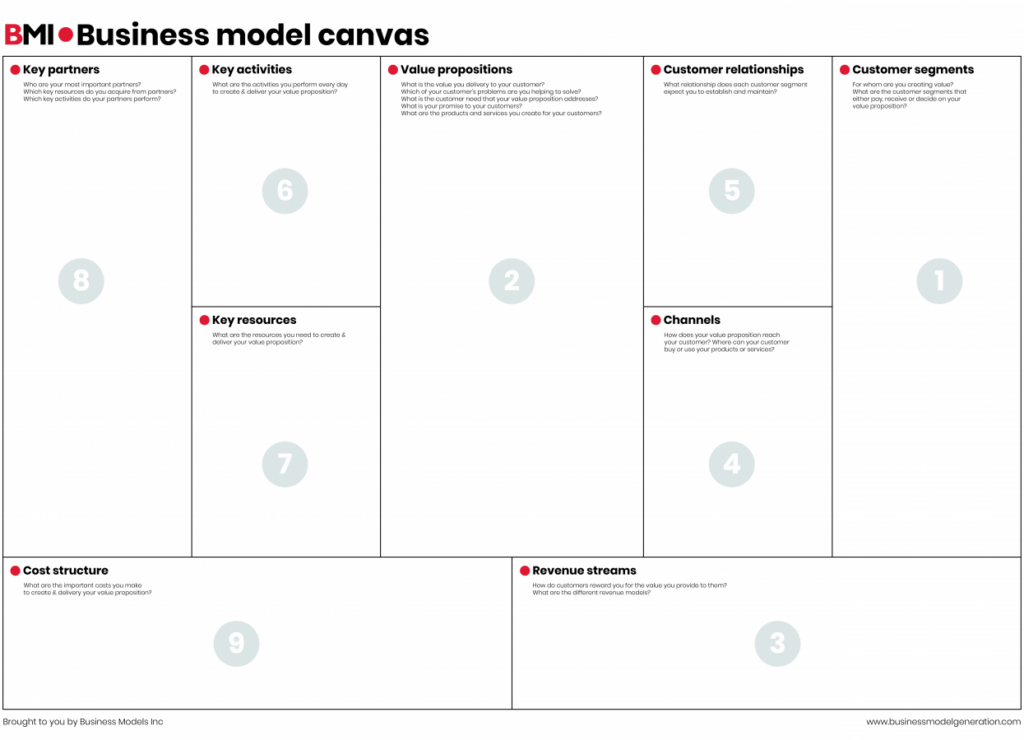[memberonly level=“Group Membership for Businesses of 2-5 individuals, Student, Individual or Solo-Preneur, PoleCon Membership”] This…

Using the Business Model Canvas to Illustrate Your Organization
For decades, business books and seminars have encouraged entrepreneurs to build a business plan, which usually includes an executive statement, financial projections, the organizational structure, etc. Ideally, the plan paints a picture of your business operations so that potential investors and other stakeholders can decide whether they want to take a risk on you/your organization.
Business plans are great! Get a template for a business plan here.
However, as the business world has evolved, so, too, has our reliance on the business plan. Enter the Business Model Canvas—a free, easy-to-use tool that can help you illustrate your organization’s value, while strategically planning and evaluating your operations.
Alexander Osterwalder and Yves Pigneur created the Business Model Canvas (BMC) in 2009 to address the challenges entrepreneurs face when communicating their ideas to stakeholders. The introduction to Osterwalder and Pigneur’s book, Business Model Generation, states “the business model is like a blueprint for strategy to be implemented through organization structures, processes, and systems.” Osterwalder and Pigneur ultimately released the tool under a creative commons license, meaning entrepreneurs and consultants can use it for free.

Use this link to download your own copy of the Business Model Canvas.
Completing the Business Model Canvas (BMC)
The BMC breaks down into nine sections, each of which represents a simplified piece of the traditional business plan:
- Customer segments
- Value proposition
- Channels
- Customer relationships
- Revenue streams
- Key resources
- Key activities
- Key partnerships
- Cost structure
Let’s look at each section using a fictional pole studio, The Pole Gym. We’ll start with the customer segments, or target audiences. The Pole Gym might be targeting two types of customers—those who regularly attend classes and those who book one-time parties. Eventually, these customer segments will interact with The Pole Gym differently so we need to identify their unique needs from the onset of our planning.
Value Proposition
Once you’ve identified customer segments, you must decide on a value proposition. This is what makes your business unique.
Ask yourself how people will remember your business? How do you frame your business offerings (services/products) in terms of the benefits you provide your customers that they will actually care about? What is the “elevator pitch” you would use to describe your business? For The Pole Gym, there are two value propositions—one for each customer segment. For our regular students, perhaps the value proposition is: “we offer high-quality pole dance instruction in a space that promotes diversity and inclusion.” The value proposition for the one-time parties would be different: “we host memorable events to celebrate any occasion at an affordable price.” Each of these statements clarifies what potential clients can expect from your business, but vary slightly based on the customer segment.
Revenue Streams
Now start planning the revenue streams. Regular students might buy weekly classes, which could be sold as packages, memberships, private lessons or maybe a combination of all of these options. Each of these becomes a revenue stream used to plan the business finances.
One-time party clients might need payment plan options as well as a single payment option, which also become revenue streams. As a general rule, diversifying revenue is a good thing, but you need to balance that with the potential increase in administrative time, energy and cost. Be creative in how to maximize revenue streams without sacrificing the value proposition(s) of your business.
Channels
Channels are the ways, methods and tools used to communicate with potential and current customers. Social media is a popular, inexpensive and common way for pole businesses to advertise. Check out these other posts for more ideas:
- The Only 3 Marketing Tips You’ll Ever Need
- What Is Affiliate Marketing?
- What Is Social Media Marketing?
Customer Relationships
Pole businesses generally excel at building gratifying customer relationships. The BMC identifies ways to maintain positive interactions with clients. These can also be strategies used to move customers from one segment to the other. For example, maybe at The Pole Gym, party attendees receive an incentive to book into the next introductory pole class. In this case, you deepen the relationship that the party attendee has with the studio and hope to move them from a one-time attendee to a regular student.
Think about the ways that you can develop a community within your business to strengthen your customer relationships.
Key Activities, Resources, and People
Key activities, resources, and people are how to deliver the value proposition. For example, The Pole Gym develops pole lesson plans in order to fully deliver on the value proposition (a key activity) for regular students. Additionally, it needs key resources like poles, crash mats, and instructor education or it will not be successful. The Pole Gym also needs partners like a landlord and/or investors to help obtain the resources (money) to deliver the value proposition. The key activities, resources, and people should complement each other, as well as the value proposition(s).
Cost Structure
Cost structure. Now that we know who our customers are and what services we provide, we can think about the costs we will incur to be successful. You’ve heard of the old saying “we have to spend money to make money.” That’s absolutely true, but if we think about all of the previous segments, we can spend our money wisely to reduce wasting resources.
For example, The Pole Gym will allocate financial resources to building a state-of-the-art studio space that offers the equipment that regular students need while also providing the perfect, celebratory atmosphere for parties.
Where do we go from here?
Now that you better understand the pieces of the Business Model Canvas, it’s time to create your own!
There are many ways to create your canvas. One way is to recreate the canvas on the large wall then use sticky notes to fill in ideas for each segment. Generate as many ideas as possible and then spend time reflecting on each segment and removing (or sometimes adding) sticky notes until the canvas becomes a perfect representation of the business. This could also be done in a list format on your computer or whatever other methods work for you.
Once you’ve designed your canvas, look at the places where you might have gaps. For example, if The Pole Gym has a customer segment for one-time parties, but the business averages only one party per month, that’s a problem the business needs to address. Maybe the studio isn’t reaching this customer segment well. Reviewing the channels segment can improve customer outreach. Or maybe the parties are priced higher than the market is willing to pay. Review revenue streams to restructure pricing.
Use this tool for introspection and be completely honest with yourself. If you identify gaps in your plan, don’t stress. Whether you’re a new business owner, or you operate an established business, the Business Model Canvas can help you fit together the “pieces” of your business to develop a cohesive strategy that complements your value proposition(s). Once you’ve pieced together this cohesive strategy, you’ll be better able to discuss your plans with investors and stakeholders.
Limitations of the Business Model Canvas
The canvas is a great tool for planning a new business or project. It can also be a great way to visually showcase your ideas. However, some stakeholders will still want to see a more formal business plan. In these scenarios, you can still use the canvas to plan your project and you can translate the ideas into a formal business plan using a template like the one in this post.
Even after planning the business, you still need to put together a schedule for implementing your plans. The BMC might uncover several gaps where you need to improve your business, but it won’t tell you how to fix these gaps or how to prioritize them. To do that, you need to analyze which fixes will have the most return on your investment. Be realistic about how many changes you can make in your timeframe. Prioritize those that will have the most positive impact on your canvas.
Conclusion
Make sure to review regularly. Sometimes, we get off track from our plans. We get distracted by new opportunities, we find enticing new ventures, or we lose interest in our plans. When this happens, we have to refocus and reorient ourselves on our goals. We can use tools like the canvas to adjust our focus when we feel distracted. While the canvas isn’t a perfect tool by any means, it’s a great guiding principle we can use when we’re feeling lost or overwhelmed by decisions.
You have a great idea; let’s bring it to life!



